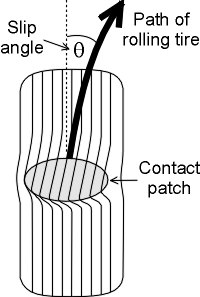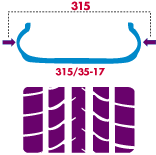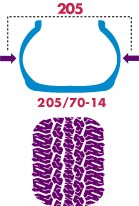Thanks everyone for the contribution and excellent posts. I hope after this thread you'll think twice every time you see a fat tire! 
Since some very knowledgeable person  has started to mention the word "slip" (slip friction) already, and I know the (possible - LOL) answer to the riddle will partly involve slip angle behavior with different shapes of the contact patch, if you are not familiar with the concept you might want to do a quick google, or wikipedia wikipeda-slip angle.
has started to mention the word "slip" (slip friction) already, and I know the (possible - LOL) answer to the riddle will partly involve slip angle behavior with different shapes of the contact patch, if you are not familiar with the concept you might want to do a quick google, or wikipedia wikipeda-slip angle.
Slip angle is an essential concept to understanding car's behavior in corner so please trust me you want to read about it if you're not already familiar  . Below is one of my favorite sites for basic level information.
. Below is one of my favorite sites for basic level information.
(In fact if you look at the highlighted sentence in the last paragraph of the quote, you'll see how I got involved with this headache.  Author made a statement linking wider tire = larger contact patch, that made me ask "why so," and upon further examination and challenge, may or may NOT be true!)
Author made a statement linking wider tire = larger contact patch, that made me ask "why so," and upon further examination and challenge, may or may NOT be true!)
>>>>>>>>>>>>>
http://www.autozine.org/technical_school/handling/tech_handling_4.htm#Neutral:
Neutral / Understeer / Oversteer
We often hear these 3 terms in car magazines. I think few people would argue if I say they are the most important elements in the study of handling.
What is understeer ? Basically, if you turn the steering wheel and find the car steers less than you expect, the car is understeering. This is not because your subjective judgement goes wrong, in fact any car must have some degree of non-neutral steering due to the weight distribution, suspension design, tyre used, lateral acceleration and road conditions. Further more, a car could understeer in this corner and then oversteer in that corner. The whole picture is very complicated, so I'll spend more paragraphs to discuss this topic.
What do we need ?
It seems that neutral steer must be more desirable than understeer and oversteer, but in fact it is not.
In fact, when running in straight line, we want a little bit understeer to make the car stable. When the car is subjected to side force, probably due to cross wind or the road's irregularities, understeer could resist the force and avoid the car to be steered automatically, therefore the driver need not to correct the steering frequently.
When the car is entering a corner, we also need a light understeer to provide the stability while the driver is easing off the brakes and building up cornering force. In mid corner, we need neutral steer. In the exit phase, a slight oversteer will be welcomed as it helps tightening the path. However, the degree of oversteer must be progressive and easily controllable by applying and easing throttle. We call this "Power Oversteer". Without power oversteer, we have to ease the throttle (thus loss time) or the car will run out of the corner.
However, I must make clear that what I say "slight understeer / oversteer" is usually deemed to be "near neutral steer" by most car magazines. This is because in reality there are too many cars running on severe understeer thus they used to them. In other words, if a car magazine said the Porsche 996 has mild understeer, it probably equals to "medium understeer" in our sense.
Basic Concept : Slip Angle
Before going on our study, we must understand the concept of slip angle first.
When a car enters a corner, all the tyres are turned with respect to the ground. Due to the elasticity of the pneumatic tyre, the tread in the contact patch will resist the turning action because there is friction generated between the rubber and the road surface. As a result, the treads on the contact patch will be distorted, whose direction always lags behind the direction of the wheel ( See figure in below ). We call the angular difference between the treads and the wheel's direction as Slip Angle.
 Note : the car is turning left
Note : the car is turning left
In which direction the wheel is running ? It is the direction of the tread, not the direciton of the wheel. I am not saying the tread has any ability to force the wheel to travel in its direction. On the contrary, the tread is only a sign showing how an arbitrary point on the tyre surface travels. If the arbitrary point travels in that direction, so does the wheel which is the summation of thousands of those points.
Now you must think the existence of slip angle must reduce the car's steering angle thus leads to understeer. In fact, it is not so if everything else are perfect. Because both the front and rear tyres have more or less the same slip angles, they counter each other thus the resulting steering angle remains unaltered.
However, if the front and rear wheels have different slip angles, then we get understeer and oversteer :
Understeer : Front Slip Angle > Rear Slip Angle
Oversteer : Front Slip Angle < Rear Slip Angle
Neutral steer : Front Slip Angle = Rear Slip Angle

.......
New Trend for RWD cars
In the past 2 decades, we saw car makers gradually increases understeer in RWD cars, making them more "secure" to drive. Porsche 996 is a good example. Its predecessor 911 used to offer hell a lot of oversteer, now the 996 becomes a very civilised GT.
This is partly due to the market orientation ( it seems the wealthy customers tend to love secure rather than excitement), partly due to the use of wider tyres. In the past 2 decades, tyres of sports cars had been widened for about 50%, in addition to the growth in diameter, the contact patch area had been largely increased. Of course this is intended to increase the grip. However, increased contact patch area means every square inches of the contact patch carries less cornering force, so the tread distort less and the slip angle is reduced.
--
Regards,
Can
997 Turbo + Bilstein Damptronic ( Review ) + GIAC ECU Tune ( Fast as a torpedo & reversible to stock - Review ) + Cargraphic Exhaust ( Oh heavenly noise!  )
)

 So if contact area doesn't matter, as so obviously shown in the equation, then a Turbo with skinny tire has as much grip as my big, fat, expensive Pilot Sport?
So if contact area doesn't matter, as so obviously shown in the equation, then a Turbo with skinny tire has as much grip as my big, fat, expensive Pilot Sport?
 )
) )
)![]()







 but the shapes of those 2 contact areas give a hint as to how the experts will try to explain this. It has to do with the following characters of the fat tire, that has the short wide patch:
but the shapes of those 2 contact areas give a hint as to how the experts will try to explain this. It has to do with the following characters of the fat tire, that has the short wide patch: ).
).





 . I could be wrong.
. I could be wrong. 




 has started to mention the word "slip" (slip friction) already, and I know the (possible - LOL) answer to the riddle will partly involve slip angle behavior with different shapes of the contact patch, if you are not familiar with the concept you might want to do a quick google, or wikipedia
has started to mention the word "slip" (slip friction) already, and I know the (possible - LOL) answer to the riddle will partly involve slip angle behavior with different shapes of the contact patch, if you are not familiar with the concept you might want to do a quick google, or wikipedia  . Below is one of my favorite sites for basic level information.
. Below is one of my favorite sites for basic level information. Note : the car is turning left
Note : the car is turning left



